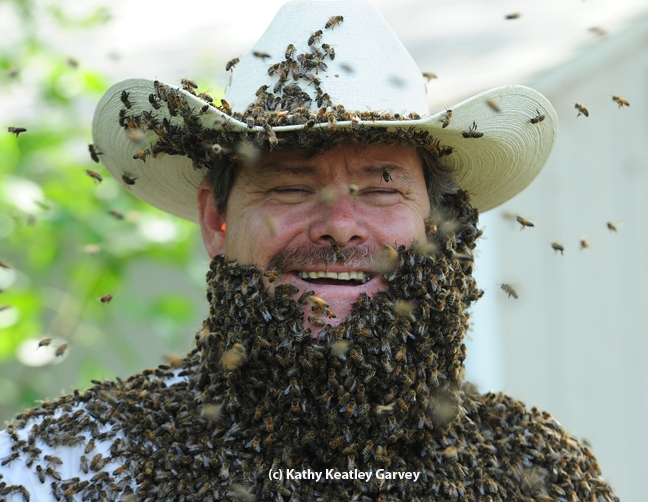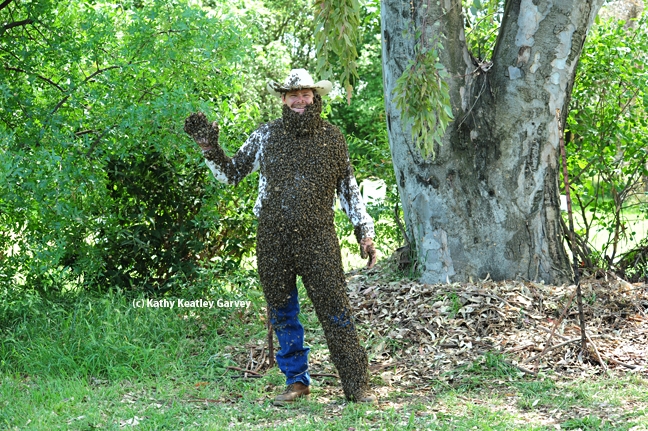It’s good to see so many children’s books being published about bees.
One of the latest ones is Buzz About Bees (Fitzhenry & Whiteside) by former elementary school teacher Kari-Lynn Winters, who asked for—and received—one of my photos of beekeeper Brian Fishback of Wilton wearing a bee beard.
Fishback, a former volunteer at the Harry H. Laidlaw Jr. Honey Bee Research Facility at the University of California, Davis, is a past president of the Sacramento Area Beekeepers’ Association and spends a lot of time educating people—especially schoolchildren—about bees. He also teaches beekeeping classes.
“From the first moment I opened a hive and held a full frame of brood covered with bees, I was in utopia,” Fishback said of his first encounter with bees in 2008. “Everything came together. In my hand I held the essence of core family values.”
That same year, he and his wife Darla purchased a ranch in Wilton and renamed it the BD Ranch and Apiary. They are their two daughters are pursuing a self-sustaining life. “I catapulted into this way of life, knowing that honey bees would provide us with pollination as well as a natural sweetener,” Fishback recalled.
And the bee beards? It’s an educational and entertaining activity best done in the spring when the nectar flow is heavy, when the temperatures are optimum, and when the bees “are fat and happy,” says noted bee breeder-geneticist Susan Cobey, formerly of UC Davis and now with Washington State University. She has coordinated bee beard activities at Ohio State University, UC Davis and now WSU.
“Don’t try this at home—not without a seasoned bee-beard coordinator who adheres to the necessary preparations and precautions,” Cobey says. “The fact that honey bees are venomous insects with the ability to sting when threatened, must be respected.”
Why bee beards? Beekeepers, she points out, are not only passionate about bees but fascinated with them. Donning a bee beard provides an opportunity to observe bee behavior up, close and personal--to literally "look the bees in the eye."
The beekeepers who participated in Cobey's beard activity last year at the Laidlaw facility agreed that the beards are "heavy, hot and they tickle." After all, we're talking about wearing 10, 000 bees!
As for Winters' new book, it's a colorful, easy-to-read work with lots of interesting facts about honey bees and other bees. It does, however, contain some incorrect information, such as:
- “The swarm can contain tens of thousands of worker bees—all following the queen.” The queen doesn’t lead the swarm, as anyone who has read bee scientist Tom Seeley’s book on The HoneyBee Democracy knows.
- Winters quotes Albert Einstein as saying: “If bees disappeared, humans would have only four years left to live.” Only problem is: Einstein didn’t say that. That’s an urban legend.
- Winters also writes that cell phones may cause interference with a bee's navigational system, which bee scientists have long discounted. She advocates creating a “cell phone-free zone” near the bee hives. “Post signs and ask people not to use cell phones in that area.” We've seen scores of beekeepers answering their cell phones in the apiary or returning phone calls.
Overall, though, this is an interesting book, with catchy chapter titles, such as “”The Whole Ball of Wax” and “Bee-Ing Alone.” We passed it around in the UC Davis Department of Entomology and Nematology. One bee scientist really liked the “Waggle Dance” poem on page 2. “Pretty good,” he said.
In addition to honey bees, Winters also touches on carpenter bees, mining bees, leafcutter bees and mason bees, which should inspire youngsters to go out and try to find them. She relates the difference between bees and wasps. She offers instruction on how to build a blue orchard bee (BOB) condo or nesting site (which we have in our back yard). There’s a fun game, “Leave Me BEE,” included in her book. And, a great recipe for a honey/lemon gargle.
By the time children finish reading the book, they're likely to (1) want to become an beekeeper (2) want to become a bee researcher or (3) just want to glean more information about bees.
For sure, they'll all appreciate bees more, thanks to this buzz about bees.
Attached Images:

